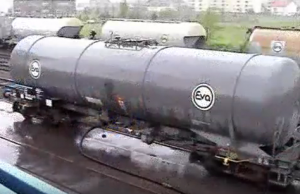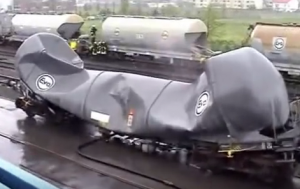Everything on model trains, model railroads, model railways, locomotives, model train layouts, scenery, wiring, DCC and more. Enjoy the world's best hobby... model railroading!
What Caused This Tank Car To Implode?
What caused this steel tanker car to get crushed like a thin aluminium pop can?
It was air pressure.
There was enough difference between the air pressure inside the tank car and the pressure of air surrounding the tank car… enough to cause the steel in the tanker to implode inwards.
Fortunately, that won’t happen on a model railroad!

















My first thought: shake hot water in a plastic bottle, empty and immedately cap it, and it will be crushed by air pressure as it cools. But this looks much more extreme !
I think the clue is in the picture: the pipe from under the tank car. Probably the load is being removed by a pump, and someone forgot to open the valve on top of the tank to let air in. So as the fluid is sucked out, a vacuum is left inside the tank, and atmospheric pressure crushes it.
“Elementary, Dr Watson.”
No, this won’t really happen on our model railroads, but what a conversation piece a model of this would be!
This is more common than one might think in the petro-chem industry. I saw a stainless steel tank about 20 ft tall by 12 ft dia crushed the same way where I used to work. The crew was steaming it out to clean it. A hose was connected to the drain at the bottom and routed to a ditch. Material was forced out sputtering and spitting endangering anyone walking by. To correct that problem the end of the hose was placed into a 55 gal drum filled with water. When the time for cleaning was up the crew shut off the steam but left the hose in the drum and didn’t open a vent. That little bit of head on the hose, maybe 1.5 psi was enough to crush the tank. It was not as severe as the tank car in the picture, but the tank had to be replaced. Expensive mistake.
Most likely the car had been steamed out and a rain shower suddenly condensed the remaining vapors leaving the tank to withstand the crushing pressure of the atmosphere (15 psi). Could also have had other warm vapors present after being emptied and similarly condensed by rain or cold air, but the degree of crushing says steam and rain to me. Stationary tanks can be designed to withstand that kind of pressure, but railcars are heavy enough without making the tank walls unnecessarily heavy. Usually stationary vessels are protected with vacuum breakers (which have to be maintained so they will open reliably upon demand) to permit air or inert gas (in case the tank contains a flammable material) to equalize the pressure. During my 35 years as Chemical Process Safety Engineer I’ve seen the power of nature under-appreciated more than once. Probably more than most readers wanted to know but I figured what the hey!
A long time ago a fellow teacher and I used mind power to crush a ditto fluid can. We cleaned the can out. Put a small amount of water in it and heated it on an electric hot plate. Our students watched as the steam came out, and then cooled a bit into water droplets that they could see. We then turned off the heat and capped the can. We cautioned the kids that we were going to use mind power to crush the can. As we have evil looks and stared at the can the students began laughing until all were having fun laughing at us. Then came a startling crunching sound. The children’s eyes grew large an the room silent. We held up the poor can the continued the lesson on the idea that air has mass and is being pulled toward the earth by gravity (weight). This the idea of air pressure and the lack of air in the now cool can.
It would have been more impressive if we could have used a tank car!